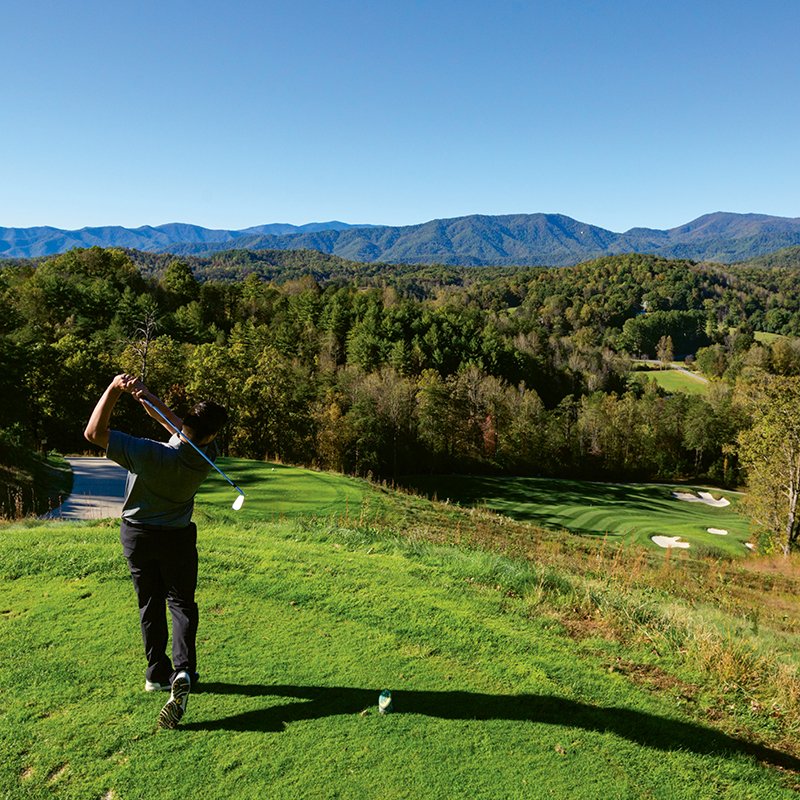Ups and Downs
Ups and Downs: Experience the essence of mountain golf with elevation changes that test even the best in the game
Sequoyah National Golf Club’s hole #15 , a par 4 that’s a classic example of downhill design.
“The ardent golfer would play Mount Everest if someone put a flagstick on top,” the renowned golf course designer Pete Dye once remarked. And while his tongue was clearly in cheek, Dye’s comment doesn’t fall terribly off the mark in Western North Carolina, where golfers have proven more than willing to tackle playing in our mountains.
In fact, dramatic elevations, as opposed to distances, are the trademark of many a mountain course—a quality that makes a round here a singular experience full of promise and peril. On the upside, the altitude and geography make for unparalleled views, whether you score a birdie or a triple bogie. On the trickier side, the unique course designs can demand uncommon feats of skill and guesswork, with some taking on the aura of optical illusions.
Just how high and low can you go with mountain golf? Here’s a selection of standout elevation-changing courses with holes that are sure to challenge (and sometimes delight) pros and amateurs alike, along with expert tips on how to make the best run at the cup.

Sequoyah National Club
Hole #15, par 4
On a clear day, you can take in 360-degree views (with Clingman’s Dome in the distance) from the #15 tee box at Sequoyah National, a Jackson County course owned by the Eastern Band of Cherokee Indians. Peering down some 200 feet to the fairway below, prepare yourself for an additional 75-foot drop to the green from there.
Pro Tip: The course’s head golf pro, Carr Crowe, says the smart play is to target your drive to the 150-yard marker, leaving you a clear path to the green on this dogleg right. Be forewarned, he says: “From the back tees, a laser [range finder] is going to say that shot is about 240 yards, but it plays more like 180.” There is another option, Crowe says, but it’s not for the faint of heart: some players have succeeded in driving the green by crossing over the dogleg—“but you’d have to hit it absolutely perfect to make that,” he cautions.
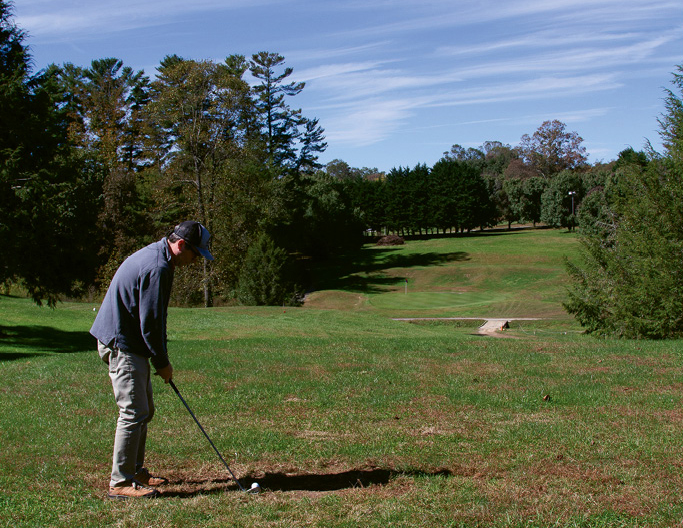
Orchard Trace
Holes #5, 6, & 7, par 3s
Among area courses, Henderson County’s Orchard Trace is a delightful departure for the budget-minded or beginner golfer—or anyone wanting to get their feet wet learning to play in the mountains. There are few drastic elevation shifts at this par 3 course that’s almost single-handedly maintained by Flaum Lamb, who built it 25 years ago and has kept the greens fees low ($20, with a cart). But there are plenty of fun gradations, and the 80-some-yard holes 5 and 6 present a perfect down and up sequence while the longer #7 drops some 100 feet from the back tees to the green.
Pro Tip: If you dial in your club and shot on the downhill #5, hit the exact same shot on the uphill #6. On #7, aim your tee shot beside or below the pin; anything longer will put you in a hard-to-play spot on a green that slopes speedily back toward the tee.

(Left) Balsam Mountain’s highest holes reach upwards of 3,700 feet in elevation; (Right) Palmer Practice Park
Balsam Mountain Preserve
Hole #8, par 4
This private community and nature preserve near Sylva sports an Arnold Palmer Signature Course that capitalizes on the splendor of impeccably designed mountain golf, and #8 is no exception. It swoops significantly down, in a way that leaves you without a clear view of your landing spot. A drive placed near the bridge will serve you well for executing your next shot, advises Travis Wilson, Balsam Mountain’s golf professional.
Pro Tip: In 2018, the course introduced Palmer Practice Park, perhaps the finest of its kind in WNC. With driving ranges to target fairways and greens, a short-game complex complete with a chipping/pitching green, a simulated fairway, a bunker, and a huge putting green, don't miss this chance for a good warm-up before hitting the links.
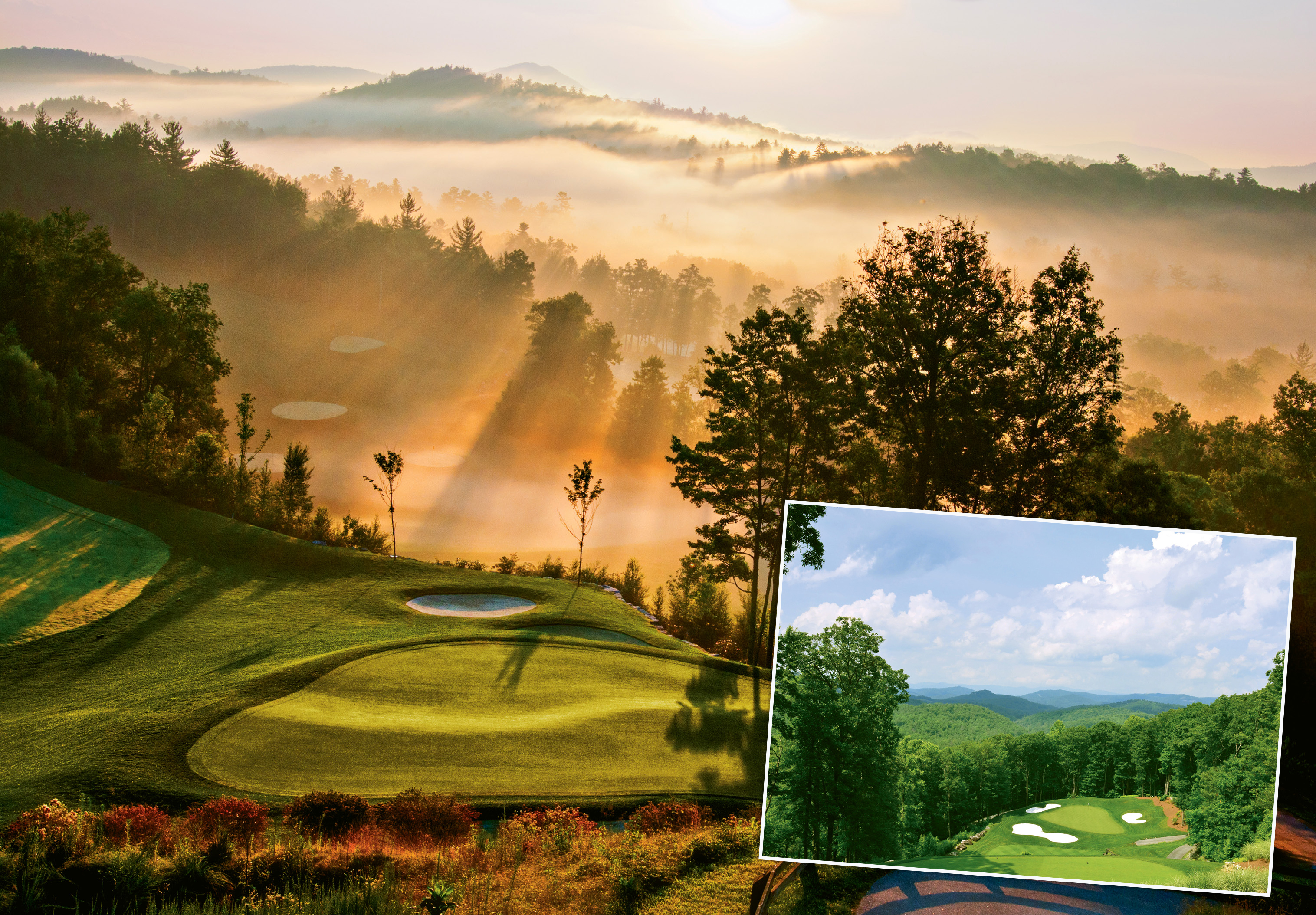
(Inset) Old Edwards' #11
Old Edwards Inn
Hole #11, par 3
Open to both members and visitors to Old Edwards’ myriad lodging options, this Macon County course is both down and up, with the front nine cruising the valleys and the back nine scaling the heights. Hole #11 drops as much as 180 feet, but it’s otherwise pretty straightforward, advises Jordan Kenter, resident director of golf. And he’s happy to report that it has something of a lucky streak going, with an average of about one hole-in-one scored here per year.
Pro Tip: The 190 yards from the back tees play more like 160, Kenter says—so he recommends selecting a club about three steps down from what you might expect. And whatever you do, err toward playing a bit short, as a shot over the green could well head “down the mountain.”

Linville Ridge's #16
Linville Ridge
Holes #13 (par 5) & 16 (par 3)
Mount Everest it ain’t, but the altitude of Linville Ridge, a country club in Avery County with ample views of neighboring Grandfather Mountain, makes it the highest golf experience east of the Mississippi. How high can you go? Find out at #13, which starts at 4,949 feet above sea level and stays there pretty much throughout. Then there’s #16, which drops the equivalent of 11 stories from tee to green. It’s hardly long, but the elevation change can be as perplexing as the hole is lovely.
Pro Tip: A not-too-terribly challenging par 5, #13 will treat you right so long as you stay close to the middle of the fairway and don’t get distracted by the scenic vistas, which have taken many a golfer astray. On #16, be sure to factor in how high winds might alter the course of your high-flying shots.
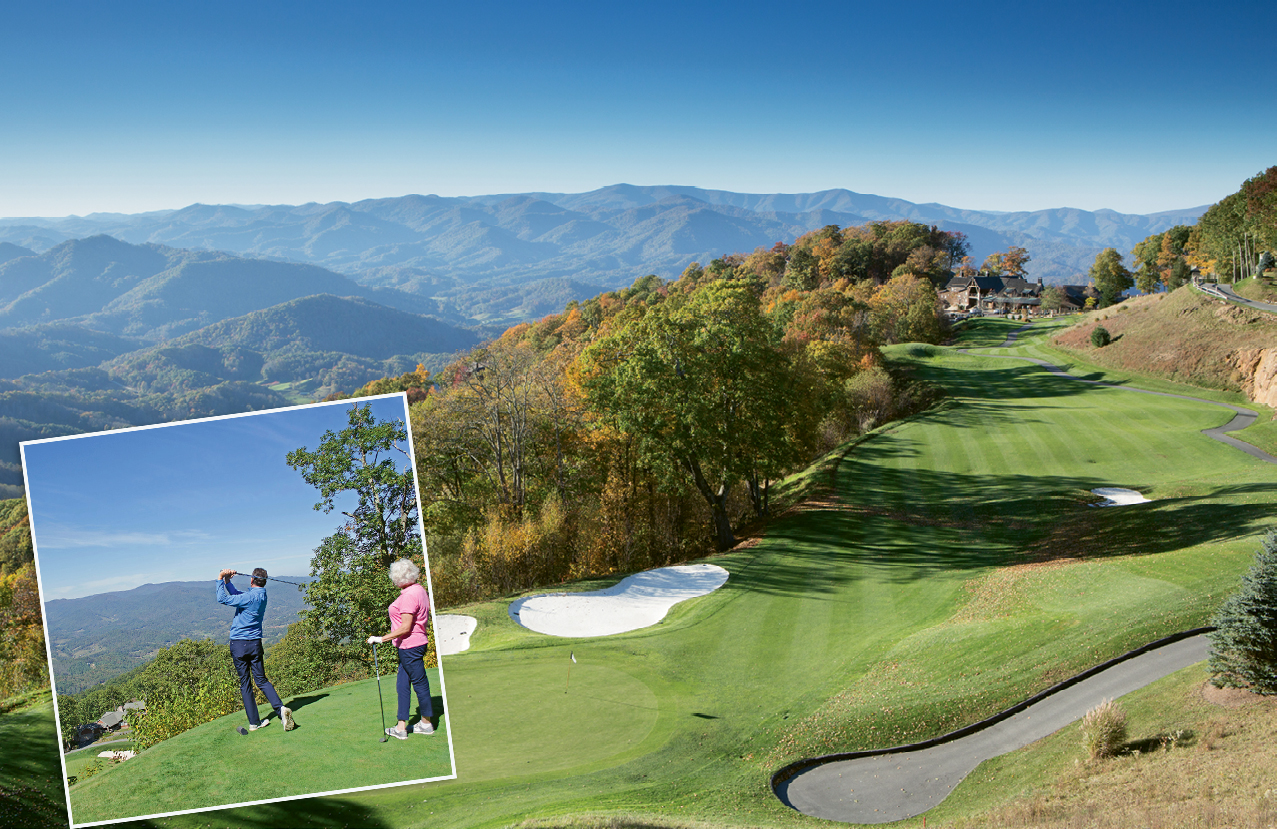
(Inset) Mountain Air's #10
Mountain Air
Hole #10, par 3
A private club near Burnsville that offers nonresident golf memberships, Mountain Air features what might be the biggest single drop to be found among North Carolina mountain courses. Hole #10 is 190 yards from the white tees, with the green a staggering 300 feet below in elevation. “It’s scary-looking, so most people will chunk it [hit it short] here,” says head golf professional Chris Parham. “Some people can’t play the hole—it scares them enough or they have vertigo or something like that, and they actually get back in the golf cart and head on down the road.”
Pro Tip: Parham advises: “The hang time on the drive is typically eight to 10 seconds, so if the wind is up to 10 or 15 miles per hour in any direction, you need to aim wide, over the hazards on either side depending on the wind direction, to be in play.”
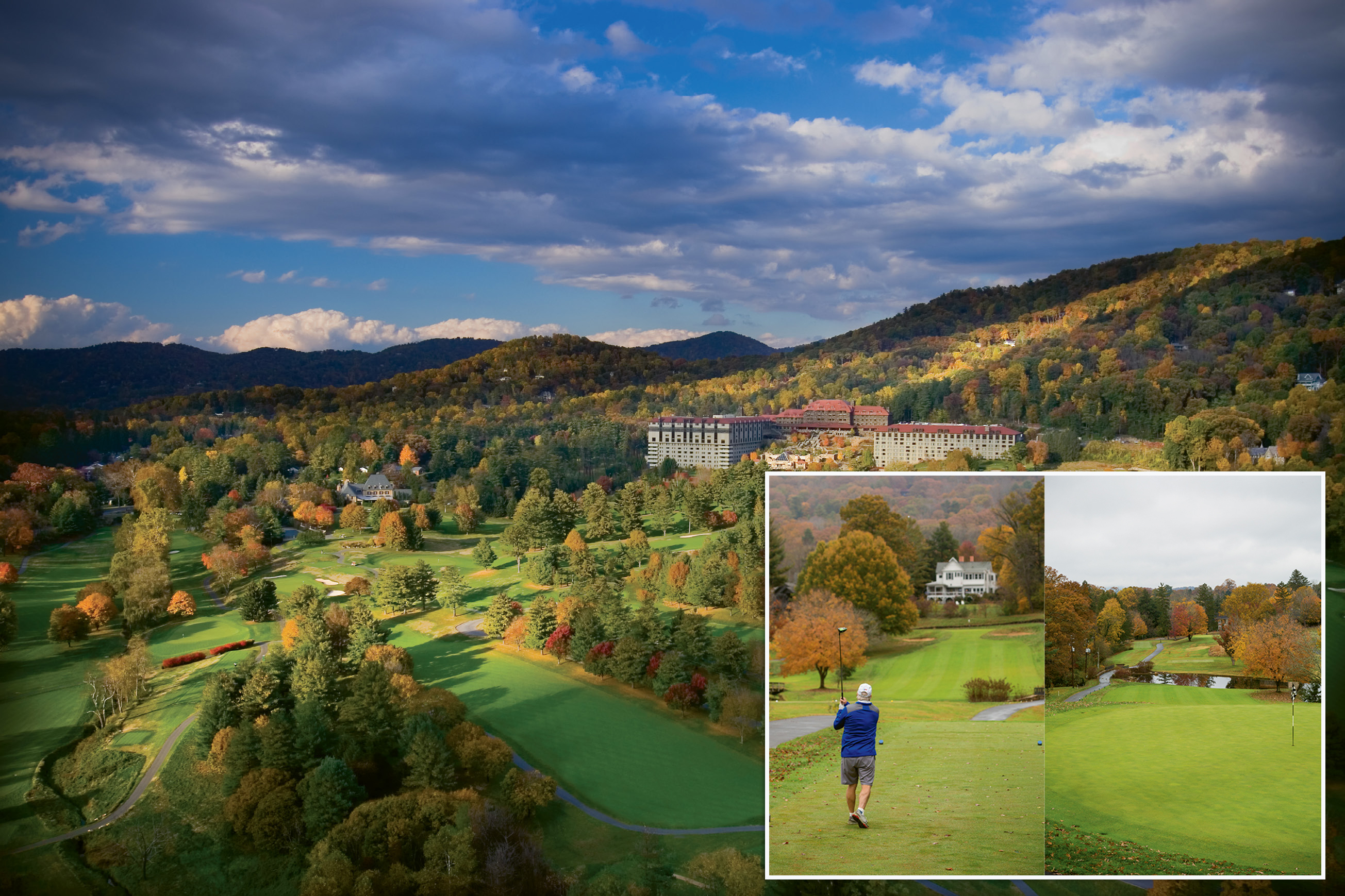
(Inset) The green on hole #6 and the tee (shown at left)
The Omni Grove Park Inn
Hole #6, par 4
A chestnut of mountain golf history, Grove Park’s course was designed in 1926 by Donald Ross, who took full advantage of the slopes heading down from the famed Asheville inn. Open to the public, Grove Park has earned a reputation for deceptively tricky ups and downs. Don’t let the relatively short (340 yards) #6 fool you: the steepest parts of the rise to the hole are right below the green, so a short approach shot might come rolling back your way.
Pro Tip: Play your approach all the way to the hole, or just beneath it; going long sets you up for a treacherous downhill chip or putt that could send your ball tumbling back into the fairway.

Olde Beau's #17
Olde Beau Resort & Golf Club
Hole #17, par 5
Olde Beau’s slogan says it all: “For a change of attitude, golf where there is altitude.” This mountaintop course in Alleghany County, open to the public, spans some 1,500 feet in elevation. Hole #17 finishes at one of Olde Beau’s lower spots after a steady downhill run that can make club selection perplexing.
Pro Tip: Olde Beau Director of Golf Steve Edwards says that a little will go a long way on your approach shot: “You can hit about a 7 iron for the last 200-yard shot,” he advises.
Bonus Tip: Check out Olde Beau’s economical “stay and play” packages, which bundle lodging at one of the resort’s villas with greens and cart fees, starting at $99.
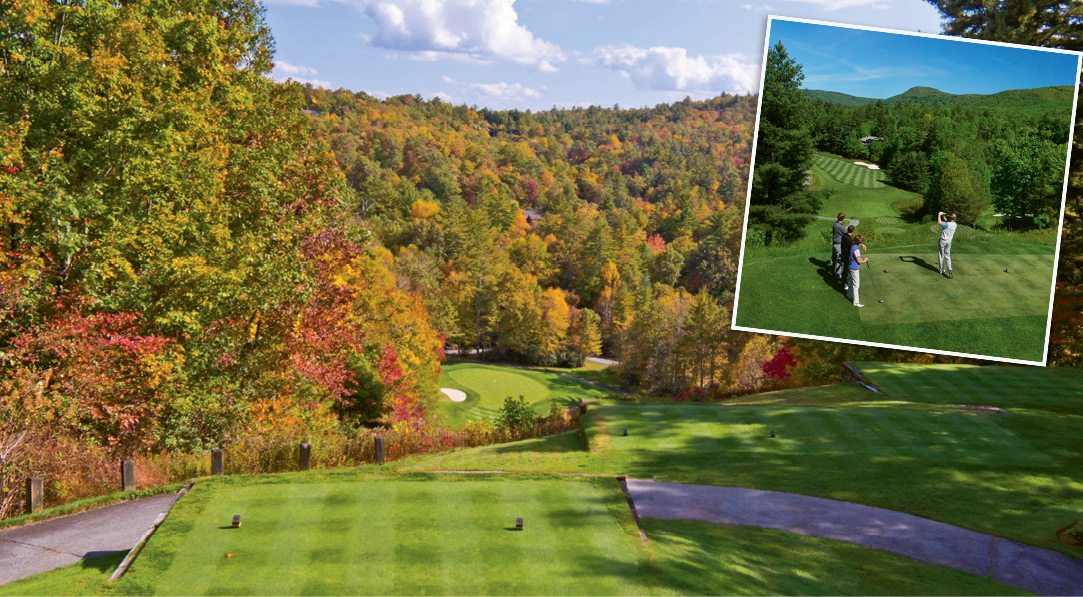
(Inset) Burlingame’s #1, where tee shots typically drop about 70 yards
Burlingame Country Club
Hole #12, par 3
Mountain golf is truly a different game,” a Burlingame club member testifies. “And every time you play our course, it plays differently.” Some things never change, though: touted as the Transylvania County course’s most memorable hole, #12 is an average-length par 3 where looks are always deceiving.
Pro Tip: Given the substantial drop to the green, veteran players recommend subtracting 20 to 60 yards from your planned shot, depending on which tees you’re playing.
